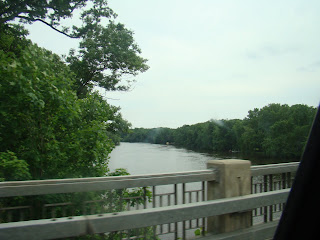Mostly I need a magic wand. I want a magic wand that I can wave to rid our property of all of the blasted multiflora roses. And the autumn olive. And the poison ivy. And that I can wave to mow the lawn. And bush hog 10 or so acres of brambles. And make my mudroom bigger on the inside, like the Weasley's tent. And wind skeins. And finish a dozen house and property projects that have been lingering for far too long around here.
If I had a wand that would do all that, then I'd have more time to blog. And weed. And cook. And bake. And can. And dye.
It's not that I don't want to do my work. It's that I have too much work to do.
I need a wand!
Sigh.
In the absence of the Magic type wands, I've made some Lavender type wands.
And since I know you need a wand or two or ten, here's how:
What you need:
- Lavender with long stems in bundles of 9 or 11 or any odd number that you want. I like 9. I try to pick my lavender just when the first blooms on the plant begin to open and before the bees really find it. You'll see good color on the buds and they'll smell fabulous.
- Ribbon. I like using 1/4" satin, but I've seen some folks use the 1/8". I like the 1/4" because it weaves around very quickly.
- Scissors
1. Cut your lavender with as long a stem as possible. My favorite lavender plant for this is Impress Purple. Super long stems! Clean off the leaves and little bitty flowers on the lower stem if necessary.
2. Cut about a yard of 1/4" ribbon [It might take 1.5 yds of the 1/8" since you have to wind it around a lot more.]
3. Tie the stems in a bundle just under the flower heads. Leave a tail of about 8 inches or so on one side. The other side will be a lot longer. Pull tight and tie a square knot.
4. Turn the whole thing upside down and bend the stems down over the ribbon tie - all around the flower head. You're making a stem cage around the flowers.
5. Leave the short side of the ribbon in the center with the flower heads. You'll need it later to tie off with.
6. With the long ribbon, start weaving over and under the stems all around the flower heads. Push the ribbon up snug around the heads next to the previous rows of ribbon. Once in a while, a little flower will try to pop out. Loosen the ribbon if you need to so you can tuck and keep the buds inside. Then pull the ribbon snug around the head and continue around.
Work all the way around and down the flower head bundle until you cover the last flower.
7. When you have covered the last flower, do one more row around, then pull the short ribbon out of the center and wind the ends around and them tightly around the stems.
Voila!
 Let air dry in a place with good air circulation.
Let air dry in a place with good air circulation. What can you do with these?
- Drop one in a drawer to use for a sachet.
- Put several in a vase.
- Leave a long loop in your last tie and loop it over a hanger in your closet.
- Tuck them in with your sheets.
- Wave the wand three times clockwise and it will clean your house for you.
OK. I'm really not too sure about that last one.

















































